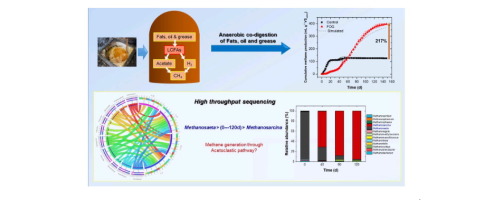Bioresource Technology ( IF 9.7 ) Pub Date : 2018-10-21 , DOI: 10.1016/j.biortech.2018.10.047 Mayur B. Kurade , Shouvik Saha , El-Sayed Salama , Swapnil M. Patil , Sanjay P. Govindwar , Byong-Hun Jeon

|
Fats, oil and grease (FOG) are energy-dense wastes that substantially increase biomethane recovery. Shifts in the microbial community during anaerobic co-digestion of FOG was assessed to understand relationships between substrate digestion and microbial adaptations. Excessive addition of FOG inhibited the methanogenic activity during initial phase; however, it enhanced the ultimate methane production by 217% compared to the control. The dominance of Proteobacteria was decreased with a simultaneous increase in Firmicutes, Bacteriodetes, Synergistetes and Euryarchaeota during the co-digestion. A significant increase in Syntrophomonas (0.18–11%), Sporanaerobacter (0.14–6%) and Propionispira (0.02–19%) was observed during co-digestion, which substantiated their importance in acetogenesis. Among methanogenic Archaea, the dominance of Methanosaeta (94%) at the beginning of co-digestion was gradually replaced by Methanosarcina (0.52–95%). The absence/relatively low abundance of syntrophic acetate oxidizers and hydrogenotrophic methanogens, and dominance of acetoclastic methanogens suggested that methane generation during co-digestion of FOG was predominantly conducted through acetoclastic pathway led by Methanosarcina.
中文翻译:

乙酸分解甲烷为首的甲烷在脂肪,油和油脂的混合厌氧消化增强沼气生产
脂肪,油脂(FOG)是能量密集的废物,可大大提高生物甲烷的回收率。评估了FOG厌氧共消化过程中微生物群落的变化,以了解底物消化与微生物适应之间的关系。过量添加FOG会抑制初始阶段的产甲烷活性。然而,与对照相比,它使最终的甲烷产量增加了217%。在共消化过程中,变形杆菌的优势降低,同时硬菌,细菌杆菌,协同菌和真鳞菌同时增加。在甲显著增加Syntrophomonas(0.18-11%),Sporanaerobacter(0.14-6%)和Propionispira在共消化过程中观察到(0.02–19%),证实了它们在产乙酸中的重要性。中甲烷古,的显性Methanosaeta(94%)在共消化的开始通过逐渐代替甲烷(0.52-95%) 。不存在/相对低丰度的互养醋酸氧化剂和氢营养甲烷,和乙酸分解甲烷的显性的FOG的共消化主要通过由主导乙酸分解途径进行期间建议甲烷产生甲烷。































 京公网安备 11010802027423号
京公网安备 11010802027423号